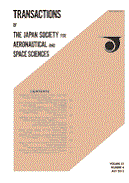
- 6 号 p. 231-
- 5 号 p. 205-
- 4 号 p. 139-
- 3 号 p. 109-
- 2 号 p. 47-
- 1 号 p. 1-
- |<
- <
- 1
- >
- >|
-
Zhongyang QI, Li ZHAO, Yankui WANG2022 年65 巻5 号 p. 205-212
発行日: 2022年
公開日: 2022/09/04
ジャーナル オープンアクセスAircraft with a blunt-nosed slender body configuration exhibit free-to-roll motion during maneuvering flight. The separation vortex on the forebody and the wing parameters are the two key factors affecting this motion. A blunt-nosed slender body configuration normally includes multiple sets of wings, which enhances the complexity of the roll motion. The strips, narrow wings, and tail rudders are installed at different axial locations on the blunt-nosed body to study the influence of wings on the roll motion. Wind tunnel experiments are conducted to investigate the motion at Reynolds number ReD = 1.54 × 105, which is based on the coming freestream velocity and diameter of the blunt-nosed body. Free-to-roll motion and aerodynamic forces are measured by the free-to-roll sting support and force balance, respectively. The free-to-roll motion is first described and divided into six regions based on the motion characteristics at 0° ≤ α ≤ 55°. The strips, narrow wings, and tail rudders are removed to investigate the effect of the wings on the roll motion. The major control performance of strips, narrow wings, and tail rudders on motion in each angle-of-attack (AOA) region are discussed in detail. The experimental results indicate that the coupling between asymmetric flow and tail rudders leads to different characteristics of free-to-roll motion at different AOAs. The asymmetric flow is closely related to the strips, narrow wings and AOA.
抄録全体を表示PDF形式でダウンロード (1628K) -
Abhas MASKEY, Pooja LEPCHA, Hari Ram SHRESTHA, Withanage Dulani CHAMIK ...2022 年65 巻5 号 p. 213-220
発行日: 2022年
公開日: 2022/09/04
ジャーナル オープンアクセスThe BIRDS series from Kyushu Institute of Technology has deployed 1U CubeSat constellations from International Space Station since 2017. BIRDS-3 was deployed in June 2019. Lessons learnt from BIRDS-1 and BIRDS-2 have been used to improve the bus system of BIRDS-3. Improvements have been made in On-Board Computer, Electrical Power and Communication systems. BIRDS-3 has implemented novel Backplane Mission which uses SoftCIB; an in-house designed software defined backplane interface board. The mission has the potential to standardize interface and cut down on development time. BIRDS-3 project has placed a LoRa module to check its performance in space. The module has the potential for future low-cost, low-powered Store and Forward mission and CubeSat communication system. This paper provides detailed information on the improved BIRDS bus system, LoRa Demonstration and Backplane Mission designs, and on-orbit results since its deployment in June 2019. The results presented are based on cumulative operation time of three years for three satellites operating each for a year. The satellites are functional and will remain in orbit until summer of 2021.
抄録全体を表示PDF形式でダウンロード (2321K) -
Rui AOKI, Ikuhiro FUJIMURA, Taro HANDA, Chungil LEE, Yuta OZAWA, Yuji ...2022 年65 巻5 号 p. 221-229
発行日: 2022年
公開日: 2022/09/04
ジャーナル オープンアクセスAn experimental study is performed to investigate the feasibility of success in controlling supersonic boundary-layer flows using a device to discharge the jets flapping at several tens of kilohertz (kHz). In the experiments, a shadowgraph image velocimetry (SIV) technique is applied for measuring the velocities in a supersonic boundary-layer flow with a freestream Mach number of 2.05. Five operations in the device are tested (i.e., the operation of discharging no jet, non-flapping jets, and jets flapping at 15 kHz, 17 kHz, and 30 kHz). The experimental results reveal that the flapping jets work so as to effectively increase the boundary layer fullness in the near-wall region as compared to that of the non-flapping jets. In addition, the operation of discharging the jets flapping at 30 kHz displays the most remarkable increase in the boundary layer fullness among the five operations. These experimental results illustrate that the device to generate a high-frequency flapping jet can be a practicable actuator for controlling supersonic boundary-layer flows.
抄録全体を表示PDF形式でダウンロード (4406K)
-
2022 年65 巻5 号 p. 230
発行日: 2022年
公開日: 2022/09/04
ジャーナル オープンアクセスPDF形式でダウンロード (29K)
- |<
- <
- 1
- >
- >|